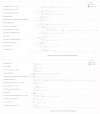Is It What They Eat or How Much They Eat That Matters More in Adults with Food Insecurity in a Wealthy-Country Context?
- PMID: 33807652
- PMCID: PMC7999059
- DOI: 10.3390/nu13030851
Is It What They Eat or How Much They Eat That Matters More in Adults with Food Insecurity in a Wealthy-Country Context?
Abstract
This study aimed to investigate whether dietary quantity and/or quality differ according to food security levels in the Korean adult population. Dietary adequacy and quality were evaluated by the Korean Dietary Reference Intake and the Korean Healthy Eating Index (KHEI) for adults, respectively, according to three food security levels, i.e., food security, low food security, and very low food security. A total of 7144 Korean adults (aged 19 to 64 years) were selected from cross-sectional data from the 2013-2015 Korean National Health and Nutrition Examination Surveys. The risk of inadequate nutrient intakes of protein (p trend = 0.021) and phosphorus (p trend = 0.002) increased according to food insecurity levels after adjustment for putative risk factors. The total KHEI scores (p < 0.001) as well as scores of having breakfast (p < 0.001) were lowest in the very low food security group. Among KHEI components, adults with food insecurity were less likely to get full scores from intakes of mixed grains (p trend = 0.016), total fruit (p trend = 0.039), fresh fruit (p trend = 0.043), and breakfast (p trend < 0.001). In addition, food-insecure adults were more likely to get zero score from intakes of fresh fruit (p trend = 0.020), milk and dairy products (p trend = 0.049), breakfast (p trend < 0.001), % of energy from sweets and beverages (p trend = 0.002), and total energy (p trend = 0.033). In conclusion, food security levels were associated with how much they ate, as well what they ate, in adults in South Korea. These results implied that the diet adequacy as well as moderation and balance could be carefully treated with food assistance or nutrition intervention once nutritional adequacy has mostly been met. In addition, targeted intervention programs tailored to diverse contexts for improving food insecurity may prevent unintended consequences due to easy access to inexpensive obesogenic foods in adults with food insecurity.
Keywords: adults; dietary adequacy; dietary quality; food insecurity; healthy eating index.
Conflict of interest statement
The authors declare no conflict of interest.
Figures

Similar articles
-
Food insecurity is inversely associated with diet quality of lower-income adults.J Acad Nutr Diet. 2014 Dec;114(12):1943-53.e2. doi: 10.1016/j.jand.2014.06.353. Epub 2014 Aug 1. J Acad Nutr Diet. 2014. PMID: 25091796
-
Household food insecurity and dietary intake in Korea: results from the 2012 Korea National Health and Nutrition Examination Survey.Public Health Nutr. 2015 Dec;18(18):3317-25. doi: 10.1017/S1368980015000725. Epub 2015 Apr 1. Public Health Nutr. 2015. PMID: 25828606 Free PMC article.
-
The Association Between Food Insecurity and Dietary Outcomes in University Students: A Systematic Review.J Acad Nutr Diet. 2021 Dec;121(12):2475-2500.e1. doi: 10.1016/j.jand.2021.07.015. Epub 2021 Aug 2. J Acad Nutr Diet. 2021. PMID: 34352437
-
Fact sheet: nationwide trends in dietary intakes among Korean adults, 2013-2022.Korean J Intern Med. 2025 May;40(3):427-437. doi: 10.3904/kjim.2024.337. Epub 2025 Mar 25. Korean J Intern Med. 2025. PMID: 40129190 Free PMC article.
-
Understanding the Food and Nutrition Insecurity Drivers in Some Emergency-Affected Countries in the Eastern Mediterranean Region from 2020 to 2024.Nutrients. 2024 Nov 11;16(22):3853. doi: 10.3390/nu16223853. Nutrients. 2024. PMID: 39599639 Free PMC article. Review.
Cited by
-
Food insecurity is associated with low diet quality and unhealthy cooking and eating habits in Iranian women.J Health Popul Nutr. 2024 Mar 14;43(1):42. doi: 10.1186/s41043-024-00533-3. J Health Popul Nutr. 2024. PMID: 38486251 Free PMC article.
-
Associations of Food Insecurity with Dietary Inflammatory Potential and Risk of Low Muscle Strength.Nutrients. 2023 Feb 23;15(5):1120. doi: 10.3390/nu15051120. Nutrients. 2023. PMID: 36904119 Free PMC article.
References
-
- GBD 2017 Diet Collaborators. Afshin A., Sur P.J., Fay K.A., Cornaby L., Ferrara G., Salama J.S., Mullany E.C., Abate K.H., Abbafati C., et al. Health effects of dietary risks in 195 countries, 1990–2017: A systematic analysis for the Global Burden of Disease Study 2017. Lancet. 2019;393:1958–1972. doi: 10.1016/S0140-6736(19)30041-8. - DOI - PMC - PubMed
-
- Kim H.R. Nutrition transition and shiting diet linked noncommunicable diseases and policy issues. Health Welf Policy Forum. 2013;198:27–37.
-
- Champagne C.M., Casey P.H., Connell C.L., Stuff J.E., Gossett J.M., Harsha D.W., McCabe-Sellers B., Robbins J.M., Simpson P.M., Weber J.L., et al. Poverty and food intake in rural America: Diet quality is lower in food insecure adults in the Mississippi Delta. J. Am. Diet. Assoc. 2007;107:1886–1894. doi: 10.1016/j.jada.2007.08.003. - DOI - PubMed
MeSH terms
Grants and funding
LinkOut - more resources
Full Text Sources
Other Literature Sources
Research Materials
Miscellaneous

